Children from illicit relationships
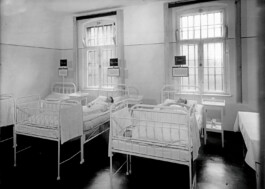
Maternity ward of the Barnimstraße prison in Berlin, ca. 1930
This prison held many women who had been sentenced for having a relationship with a prisoner of war. Pregnant women were sent to this ward for a short time to give birth.
Photo: unknown. Berlin State Archive
Despite severe penalties for illegal contact between Germans and prisoners of war or forced labourers, many children were born from these relationships—they were “nevertheless there”. The number of these children is unknown and difficult to determine. Many were never discovered because their parents’ relationship remained secret, because the children never learnt that they came from an illicit relationship, or because they were separated from their mothers during the war. Some women decided to have an abortion or were pressured into doing so.
Children from illicit relationships were also affected by bombing raids, evacuations, and hostilities. As a result, they were often separated from their families. German fathers were usually at the front or killed in action, and in the turmoil of the war, some children from illicit relationships also went unnoticed.
Nazi authorities treated these children differently depending on the origin of the non-German parent. During the German mothers’ imprisonment, the children were often placed in a home or with their mother’s family. From 1943 onwards, children of forced labourers from Poland and the Soviet Union were usually placed in “Ausländerkinder-Pflegestätten” (foreign children care centres), where mortality rates were high due to deliberate neglect.
Pregnancies
Pregnancy increased the risk that an illicit contact would be discovered. Some women therefore opted for an abortion, which was also a punishable offence. A few cases of infanticide are documented as well. Women from Poland and the Soviet Union, in particular, were often forced to have an abortion, even at an advanced stage of pregnancy. If German women or female forced labourers were pregnant when sent to a concentration camp, they had to give birth to their children there or were forced to have an abortion. Most of these children did not survive. German women sentenced to prison, on the other hand, were in some cases allowed to stay at home until their child was born and only then had to start their prison sentence, or they gave birth in a prison maternity ward.
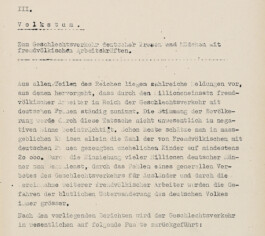
“Reports from the Reich” of the SS Security Service, No. 253, 22 January 1942, excerpt
In January 1942, the NSDAP estimated the number of children born from these relationships at 20,000, a figure that cannot be verified.
Federal Archives
“Germanisation” and the murder of children
Many newborns and infants were taken away from their parents during the war for various reasons. This also affected children from forbidden relationships. How these children were specifically treated was based on the principles of National Socialist racism. Children who appeared to be “Aryan” could undergo an “Eindeutschungsverfahren” (Germanisation procedure), as could some forced labourers. The children would then be forcibly adopted by a German family. Others were placed in “foreign children care centres”. Here the children of Eastern European mothers were deliberately neglected and had little chance of survival. There were also children’s homes for the children of female Western European forced labourers, which were mostly run by the companies for whom these mothers worked. Their conditions were somewhat better than in the “foreign children care centres”.
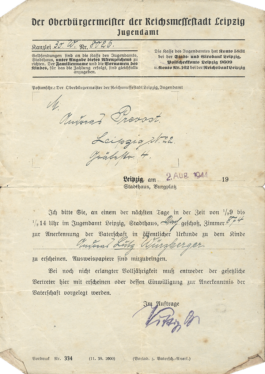
Request for acknowledgement of paternity by Lutz Würzberger, Leipzig, 2 August 1944
The former French prisoner of war André Prévost, whose status had been changed to “civilian labourer”, acknowledged his son with a German woman. Despite this acknowledgment, the parents were not prosecuted.
Privately ownded by Würzberger
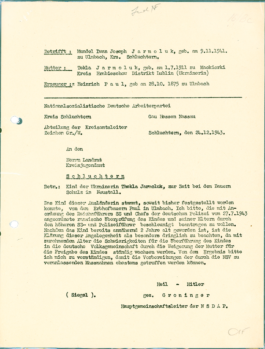
Application for “Germanisation” of the child Ivan Yarmoluk, 24 December 1943
The NSDAP in the district of Schlüchtern in Hesse applied for a “Germanisation procedure” for the child of a Ukrainian forced labourer and a German man.
Arolsen Archives
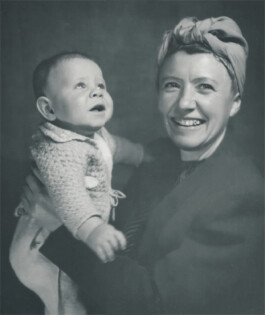
Hanna Ahrens from Worpswede near Bremen with her son Michael Ahrens, 1943
Michael’s father was a French prisoner of war. A German friend of his mother acknowledged his paternity in order to protect all three of them from persecution.
Photo: unknown. Private property Fenken
“Hidden” children
Many children from illicit relationships remained in the families of their German mothers. If the mothers were sentenced to prison, the family, grandparents, or a trusted person looked after the children. Some were temporarily placed in a home during the imprisonment and returned to their mothers after the latter were released. In most cases, however, the children’s origins remained hidden. A few children were reported as the husband’s biological children when the illicit relationship was uncovered. In other cases, the mothers named an “unknown” German soldier as the father. At times the parents’ relationship was known to those around them but was not reported. In some cases of undisclosed relationships, the fathers tried to look after and maintain contact with the child.
Children from illicit relationships

Maternity ward of the Barnimstraße prison in Berlin, ca. 1930
This prison held many women who had been sentenced for having a relationship with a prisoner of war. Pregnant women were sent to this ward for a short time to give birth.
Photo: unknown. Berlin State Archive
Despite severe penalties for illegal contact between Germans and prisoners of war or forced labourers, many children were born from these relationships—they were “nevertheless there”. The number of these children is unknown and difficult to determine. Many were never discovered because their parents’ relationship remained secret, because the children never learnt that they came from an illicit relationship, or because they were separated from their mothers during the war. Some women decided to have an abortion or were pressured into doing so.
Children from illicit relationships were also affected by bombing raids, evacuations, and hostilities. As a result, they were often separated from their families. German fathers were usually at the front or killed in action, and in the turmoil of the war, some children from illicit relationships also went unnoticed.
Nazi authorities treated these children differently depending on the origin of the non-German parent. During the German mothers’ imprisonment, the children were often placed in a home or with their mother’s family. From 1943 onwards, children of forced labourers from Poland and the Soviet Union were usually placed in “Ausländerkinder-Pflegestätten” (foreign children care centres), where mortality rates were high due to deliberate neglect.
Pregnancies
Pregnancy increased the risk that an illicit contact would be discovered. Some women therefore opted for an abortion, which was also a punishable offence. A few cases of infanticide are documented as well. Women from Poland and the Soviet Union, in particular, were often forced to have an abortion, even at an advanced stage of pregnancy. If German women or female forced labourers were pregnant when sent to a concentration camp, they had to give birth to their children there or were forced to have an abortion. Most of these children did not survive. German women sentenced to prison, on the other hand, were in some cases allowed to stay at home until their child was born and only then had to start their prison sentence, or they gave birth in a prison maternity ward.

“Reports from the Reich” of the SS Security Service, No. 253, 22 January 1942, excerpt
In January 1942, the NSDAP estimated the number of children born from these relationships at 20,000, a figure that cannot be verified.
Federal Archives
“Germanisation” and the murder of children
Many newborns and infants were taken away from their parents during the war for various reasons. This also affected children from forbidden relationships. How these children were specifically treated was based on the principles of National Socialist racism. Children who appeared to be “Aryan” could undergo an “Eindeutschungsverfahren” (Germanisation procedure), as could some forced labourers. The children would then be forcibly adopted by a German family. Others were placed in “foreign children care centres”. Here the children of Eastern European mothers were deliberately neglected and had little chance of survival. There were also children’s homes for the children of female Western European forced labourers, which were mostly run by the companies for whom these mothers worked. Their conditions were somewhat better than in the “foreign children care centres”.

Request for acknowledgement of paternity by Lutz Würzberger, Leipzig, 2 August 1944
The former French prisoner of war André Prévost, whose status had been changed to “civilian labourer”, acknowledged his son with a German woman. Despite this acknowledgment, the parents were not prosecuted.
Privately ownded by Würzberger

Antrag auf »Eindeutschung« des Kindes Iwan Jarmoluk, 24. Dezember 1943
Die NSDAP im Landkreis Schlüchtern in Hessen beantragte ein »Eindeutschungsverfahren« für das Kind einer ukrainischen Zwangsarbeiterin und eines deutschen Mannes.
Arolsen Archives

Hanna Ahrens from Worpswede near Bremen with her son Michael Ahrens, 1943
Michael’s father was a French prisoner of war. A German friend of his mother acknowledged his paternity in order to protect all three of them from persecution.
Photo: unknown. Private property Fenken
“Hidden” children
Many children from illicit relationships remained in the families of their German mothers. If the mothers were sentenced to prison, the family, grandparents, or a trusted person looked after the children. Some were temporarily placed in a home during the imprisonment and returned to their mothers after the latter were released. In most cases, however, the children’s origins remained hidden. A few children were reported as the husband’s biological children when the illicit relationship was uncovered. In other cases, the mothers named an “unknown” German soldier as the father. At times the parents’ relationship was known to those around them but was not reported. In some cases of undisclosed relationships, the fathers tried to look after and maintain contact with the child.
nevertheless here!—Children from forbidden relationships between Germans and prisoners of war or forced labourers is a project of the Sandbostel Camp Memorial sponsored by the Foundation Memory, Responsibility, and Future (EVZ Foundation) and the German Federal Ministry of Finance according to the Education Agenda NS-Injustice.
Cooperative partners are the Neuengamme Concentration Camp Memorial, the project Multi-peRSPEKTif (Denkort Bunker Valentin / Landeszentrale für politische Bildung Bremen) and the Competence Center for Teacher Training Bad Bederkesa.

nevertheless here!—Children from forbidden relationships between Germans and prisoners of war or forced labourers is a project of the Sandbostel Camp Memorial sponsored by the Foundation Memory, Responsibility, and Future (EVZ Foundation) and the German Federal Ministry of Finance according to the Education Agenda NS-Injustice.
Cooperative partners are the Neuengamme Concentration Camp Memorial, the project Multi-peRSPEKTif (Denkort Bunker Valentin / Landeszentrale für politische Bildung Bremen) and the Competence Center for Teacher Training Bad Bederkesa.

